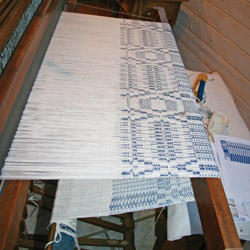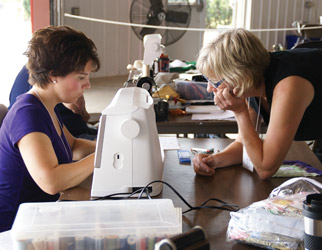It’s the same story you’ve heard many times—schools are dropping the arts from their curricula in order to meet state and federal requirements. But long before No Child Left Behind, the manual arts—crafting and fabric arts, woodcraft, metalwork and the like—had been on the wane for decades. These days, you’d be hard-pressed to find classes in loom weaving or woodworking at most high schools and colleges.
And it’s the slow disappearance of these skilled arts that has Lisé Mundwiller, Joan Quigg and Jennie Hawkey concerned. The three women, all weavers, were spurred into action several years ago by the passing of a friend who owned a yarn shop in Peoria Heights called Skeins & Shuttles. While contemplating whether to open another yarn shop in the area, Mundwiller, Quigg and Hawkey decided they would much prefer to teach others how to use yarn than sell it.
Realizing that more was at stake than just weaving—other arts and crafts are in danger of being lost as well—they thought a folk art school might be just the answer. And so, in 2007, the three friends embarked on an odyssey to visit four such schools. Four days and 2,400 miles later, after visiting Arrowmont School of Arts and Crafts in Tennessee and the Sawtooth School for Visual Arts, Penland School of Crafts and John C. Campbell Folk School in North Carolina, “we had an idea of what people offer and what we were interested in,” explained Hawkey. And with their examples as inspiration, the Three Sisters Folk Art School was born.
As its namesake suggests, classes are held at Three Sisters Park in Chillicothe, and most take place in the pavilion—at least until the school has bricks and mortar of its own, one of the ladies’ primary goals. “We have a couple opportunities that could easily put it so that we would have a building of our own within a year or two,” said Mundwiller, although such plans have yet to be finalized.
Classes take place over a three-day weekend, beginning on Friday evening and continuing through Sunday afternoon. Everyone comes together for breakfast and lunch on Saturday and Sunday, allowing students and teachers from different classes a chance to mingle and learn what others are working on. Mornings and afternoons are spent in class working on projects, while evenings offer open studio time for those who wish to continue their work.
Students range in age from their 20s to their 70s, and the classes draw nearly equal numbers of men and women. Some married couples take classes together, each focusing on his or her own interests. The man may learn blacksmithing, while the woman learns quilting, for example; the two can join each other for meals and go their own ways during class and studio times. Class sizes are small, allowing teachers to work closely with the students and provide individual attention based on their different levels of skill.
 More Than Hobbies
More Than Hobbies
When Mundwiller, Quigg and Hawkey speak of their plans for the Three Sisters Folk Art School, their eyes light up, and their voices get a bit brighter—it’s quite obvious that this is their passion. All three started crafting at a young age, so it makes sense that these arts are more than just hobbies to them.
When she was just four, Quigg was taught how to cross stitch by her grandmother. “Once I started,” she recalled, “you couldn’t get me away from any kind of yarn, thread, fabric…you name it!” Though she uses her nursing degree to pay the bills, her first degree was in fashion and textile design, and that’s where her passion remains. “I’d much prefer to be working with fabric.”
Hawkey’s mother was an avid seamstress, and taught her daughter to sew at a young age. After taking a weaving class in high school, Hawkey continued with the art in college, taking classes when she could while she pursued her degree in education.
Mundwiller has been involved with fiber since she was a little girl, having learned to knit at age six. A full-time nurse as well, she didn’t have the time to take weaving classes until about seven years ago, when she signed up for classes at Skeins & Shuttles. She quickly fell in love, just as she had previously done with cooking, jewelry making and basket weaving.
These ladies’ longtime history with folk art was instrumental in their ambitions to start a folk art school here in central Illinois, but so was the possibility that these arts could die out. “We want to teach the arts that have been passed down from generations before they disappear,” Mundwiller explained. “So many are not being taught in the schools anymore.”
She offered the example of a type of knitted lace that was all but lost in the British Isles. Half a century ago, a lone woman took it upon herself to visit some of the elders who were still practicing the art and learn their techniques before they passed away. Now, she is making sure their craft survives. “If we don’t teach [the arts] to the next generation,” said Mundwiller, “we’re going to lose them.”
For many, the hesitation to take up folk arts like weaving or blacksmithing derives in part from a lack of the necessary tools. Looms, for example, can easily cost a thousand dollars, so it’s rather difficult for interested parties to just “try it and see.” They’re also not generally available at the average arts and crafts store. And anvils aren’t cheap or easy to come by, either. On the other hand, a pair of knitting needles and a skein of yarn can be purchased for under $20.
“By having a school, we can offer the equipment that people don’t have,” declared Hawkey. And in addition to costly equipment, the school brings in experienced artists from the local community and beyond to help guide prospective craftspeople. Firm believers that artists must be supported and fairly compensated for their work, the trio uses grants and tuition fees to pay those who teach at the school.
 Crafting a Bright Future
Crafting a Bright Future
With plans to build a school in the next couple of years—and dreams of one day adding lodging to attract more students from out of town—Mundwiller, Quigg and Hawkey are gearing up to raise funds on a larger scale. They’ve started a cooperative project that involves constructing a miniature model school, which Quigg has christened the “Spirit of the School.” Students in woodworking classes can make small furniture for the model, while weavers can fashion rugs to go inside. “The idea is that when we go out and really start fundraising, we can take this as an example, or inspiration, so people can see what we’re talking about,” said Hawkey.
Part of an international phenomenon, Swap-O-Rama-Rama Chicago is another venue in which the Three Sisters Folk Art School has gained exposure. Attendees bring a $20 donation and a bag of clothes they no longer want, which serves as raw material for new creations using sewing machines, silk screens, dyes and more. A fun event that promotes recycling through creative reuse, Swap-O-Rama-Rama is a great opportunity to introduce the folk art school to a wider audience.
“Eventually, when we become fully operational, we see our target market as the Midwest,” explained Hawkey. “Sitting as we do between Chicago, St. Louis and Indianapolis, we see this as a large market area for a vacation destination such as the folk art school.”
As the arts—folk art and otherwise—continue to disappear from schools across the country, Mundwiller, Quigg and Hawkey are doing their part to carry on traditions that have passed from generation to generation. With a few successful workshop weekends behind them and grand plans for the future, they are well on their way to carving out a niche in central Illinois. a&s
UPCOMING CLASSES April 15th to 17th
Tuition is $135 per class. Some additional materials fees may apply. Visit threesistersfolkartschool.com or call (309) 274-8837 for more info.
NEEDLE SCULPTING AN ART DOLL—Learn the art of needle sculpting. Create your own 3D sculpture of a whimsical character complete with garments, all made from roving wool.
PINHOLE PHOTOGRAPHY—Learn about pinhole photography; construction of a camera; and loading, shooting and developing photos.
SEWING AND A LITTLE MORE—Students will create two projects, a casserole tote and a simple apron. Use an embroidery machine during class to add personalized embellishments.
INTRODUCTION TO LATHE WORK—Learn basic woodturning styles and methods while working on at least three projects. For beginners and experienced beginners.
LACE KNITTING—Even less experienced knitters can learn the basics of lace knitting, key stitch combinations and hints for making perfect lace. Students will learn how to choose lace patterns for specific projects, the different lace styles and how to block a finished project.
WOODCARVING—Start carving Christmas ornaments now! The ornaments will be made using sharp tools, so instruction will include safety procedures as well as technique.
FINE METAL CLAY & JEWELRY MAKING TECHNIQUES—Learn the history, composition and methods of transforming metal clay into pure silver. Shape, carve or mold your piece into a design, then dry, fire and polish your finished piece. Students will also learn basic jewelry techniques of wire wrapping and bead stringing.
RUG HOOKING—Learn the art of traditional rug hooking, in which colorful strips of dyed wool are pulled through a fabric backing to create beautiful rugs, coasters, bags, runners and more. Beginners and advanced hookers welcome.


